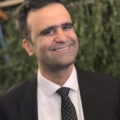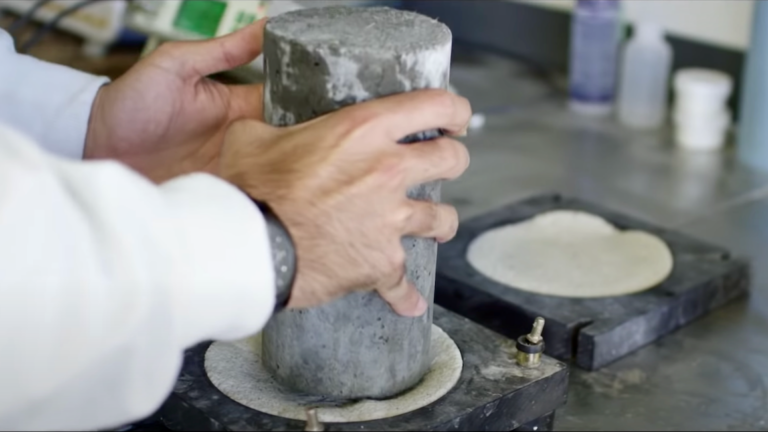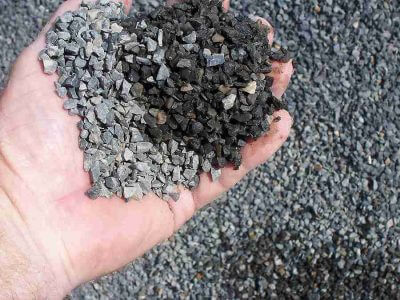Concrete forms the foundation of most construction projects, from skyscrapers to bridges. Its quality directly impacts the safety and longevity of these structures. Accredited concrete testing labs play a crucial role in guaranteeing that the concrete used meets stringent standards. This ensures structural integrity, durability, and compliance with industry regulations. This blog highlights why using a professional concrete testing lab is crucial and how they add value to the maturity method and real-time monitoring, providing more accurate insights into concrete performance.
Biggest SmartRock® Savings of the Year are Here!
The Purpose of a Concrete Testing Lab
Concrete testing labs perform a range of essential tests to verify the quality of concrete. These tests provide critical information about the concrete’s workability, strength, and durability, ensuring it meets the specific requirements of a project. The three most common key tests include:
- Compressive Strength Test- ASTM C39/C39M-24
In the lab, cylindrical concrete samples are subjected to pressure to determine their compressive strength. This test ensures that the concrete will meet the structural load demands of the project. - Air Content Test- ASTM C231/C231-24
Proper air content enhances concrete’s resistance to freeze-thaw cycles, crucial in regions with fluctuating temperatures. This test measures the air voids in fresh concrete, which directly affects its durability. - Slump Test- ASTM C143/C143M-20
This in-field test measures the workability of fresh concrete. A proper slump test ensures the water-cement ratio is correct. This is vital to achieving the required consistency and avoiding problems like cracking.

What Services Do Concrete Testing Labs Provide?
Concrete testing labs offer a comprehensive range of services to evaluate the quality, strength, and durability of concrete materials used in construction. These services help ensure compliance with building codes and industry standards, while also contributing to the long-term performance and safety of structures.
Core Services Offered:
Fresh Concrete Testing
Testing fresh concrete at the job site ensures it meets mix design specifications and is suitable for placement. Key services include:
- Slump testing to assess workability.
- Air content measurement for freeze-thaw durability.
- Casting and curing of test specimens (cylinders or cubes) for strength testing.
Hardened Concrete Testing
Once the concrete has cured, labs perform:
- Compressive and flexural strength tests to evaluate load-bearing capacity.
- Split tensile strength tests for cracking resistance.
- Water absorption and density tests to assess durability.
Durability and Permeability Assessments
Labs test for long-term resilience against environmental conditions with:
- Rapid chloride permeability tests for structures exposed to deicing salts or marine environments.
- Hardened air void analysis for freeze-thaw resistance.
- Non-destructive tests like ultrasonic pulse velocity or rebound hammer evaluations.
Mix Design and Material Evaluation
Testing labs support material optimization and mix design development through:
- Quality testing of aggregates, cement, and admixtures.
- Trial batching and performance evaluation of custom mixes.
- Review of supplementary cementitious materials like fly ash or slag.
Quality Control and Compliance Monitoring
To ensure reliable performance during construction, labs assist with:
- On-site inspections of concrete placement and curing.
- Compliance testing with ASTM, ACI, and local standards.
- Forensic investigations to identify causes of deterioration or failure in existing structures.
Technical Consulting and Reporting
Professional labs also provide:
- Expert consultation on specifications and troubleshooting.
- Detailed technical reports with clear interpretations for engineers and project managers.
Why These Services Matter
From the initial pour to long-term structural assessment, concrete testing labs provide critical data and expertise. By identifying issues early and validating material performance, they help contractors:
- Avoid costly rework or failures
- Meet project timelines with confidence
- Ensure long-term durability and compliance
When choosing a lab, ensure it is accredited (e.g., ISO/IEC 17025, ASTM, AASHTO) and equipped with advanced technologies, such as maturity sensors and non-destructive testing tools, to support both traditional and modern quality control methods.
The Role of Concrete Testing in Industry Compliance
Concrete testing labs help ensure that projects follow established standards such as ASTM and ACI and meet local building codes. Compliance with these standards is essential for preventing issues like structural failure and ensuring the long-term stability of the project.
Key Industry Standards:
- ASTM International: Provides standards for the physical and mechanical properties of concrete.
- American Concrete Institute (ACI): Sets building codes and construction practices related to concrete structures.
- Local Building Codes: Often adopt elements from ASTM and ACI, ensuring public safety and compliance with legal standards.
Ensuring Long-Term Durability:
Concrete testing labs not only ensure that the material meets initial standards; they also help prevent long-term issues like cracking, spalling, and water infiltration. Some critical aspects of durability include:
- Low Permeability: Testing ensures the concrete is resistant to water infiltration, preventing spalling and freeze-thaw damage.
- Proper Curing: The curing process is key to preventing early-stage cracking. Sensors and the maturity method help verify that the curing conditions are optimal.
Choosing the Right Concrete Testing Lab
Selecting a professional and accredited concrete testing lab is essential for maintaining the quality and safety of your construction project. Key considerations include:
- Accreditation: Ensure the lab is accredited by recognized bodies like NATA, AASHTO, or ISO/IEC 17025 to guarantee accurate and reliable test results.
- Location: The proximity of the lab can affect turnaround times and costs, so choose one that is conveniently located while maintaining high standards.
- Capabilities: Verify that the lab has the necessary equipment and expertise to perform all required tests, including advanced monitoring technologies and the maturity method.
Biggest SmartRock® Savings of the Year are Here!
Technological Advancements: Real-Time Monitoring and Maturity Method
Recent advancements in concrete testing are revolutionizing the way construction professionals monitor and assess concrete performance. Two critical innovations include real-time monitoring with embedded sensors and the maturity method.
Real-Time Monitoring Using Embedded Sensors
Real-time monitoring with sensors allows for continuous tracking of key parameters like temperature, moisture, and stress during the concrete curing process. Embedded sensors provide immediate feedback on the curing environment. This enables contractors and engineers to make timely adjustments that prevent future structural issues.
This technology offers several advantages:
- Immediate Feedback: Sensors track real-time changes, ensuring the concrete is curing within optimal conditions.
- Early Problem Detection: Engineers can detect potential problems, such as rapid moisture loss or temperature fluctuations, and correct them before they lead to issues like cracking or inadequate strength.
- Long-Term Monitoring: Some sensors continue to monitor the concrete’s performance after curing, helping to prevent long-term durability problems.
The Maturity Method: Predicting In-Place Concrete Strength
The maturity method is another valuable tool for predicting the strength of in-place concrete by considering the combined effects of time and temperature. This non-destructive testing method allows engineers to estimate the concrete’s strength at various stages of curing without breaking samples. By collecting data on the concrete’s temperature history, the maturity method provides accurate insights into its strength development over time.
Benefits of the Maturity Method Include:
- More Accurate Strength Estimates: Unlike compressive strength tests, which rely on small lab samples, the maturity method gives a better indication of the concrete’s actual in-place strength.
- Faster Project Progress: Since it provides early strength data, engineers can make informed decisions on when to move forward with construction, potentially speeding up project timelines.
- Improved Safety: Real-time strength estimates ensure that the concrete has reached sufficient strength before structural loads are applied, reducing the risk of early-stage failures.
It is recommended to use in-place testing methods like maturity testing to monitor concrete strength. SmartRock® sensors, paired with a phone app, provide temperature and strength data every 15 minutes via a wireless signal, eliminating the need for wires. This enhances site safety and ensures precise monitoring (±0.1°C), helping contractors adjust heating during cold weather, reduce energy costs, and streamline project schedules.

Conclusion
A reliable concrete testing lab ensures your project meets industry standards and avoids costly failures. With advancements like real-time monitoring and the maturity method, labs offer accurate insights into concrete performance, helping engineers address issues early and predict concrete strength. Choosing an accredited lab with these technologies safeguards project quality and compliance. For a balanced approach to testing, select a lab that offers both traditional and advanced methods (like the maturity method).









